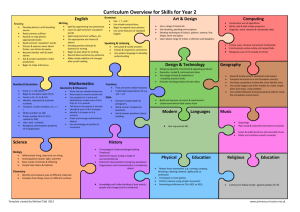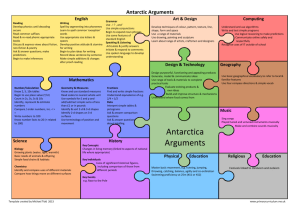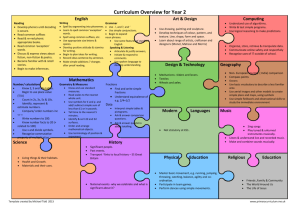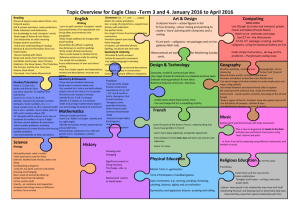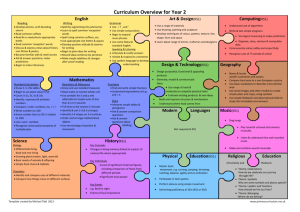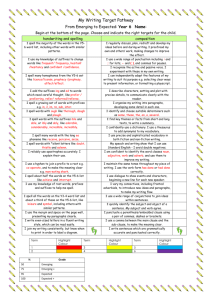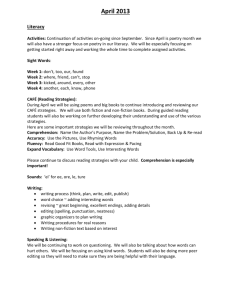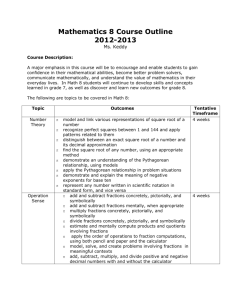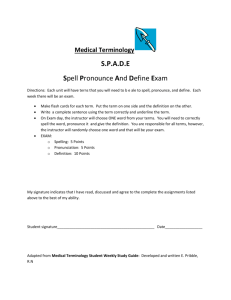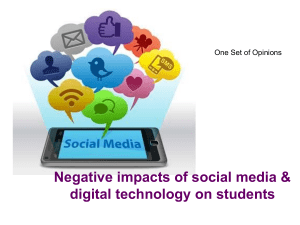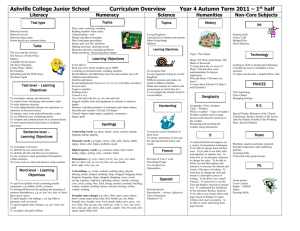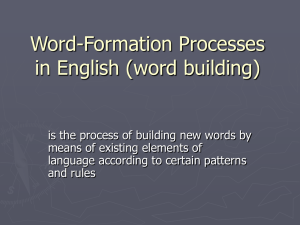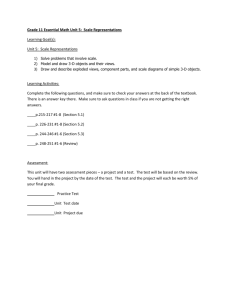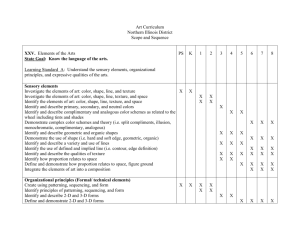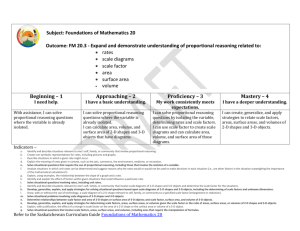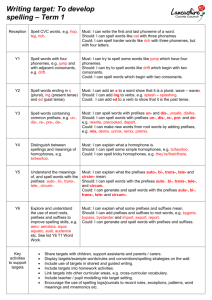Curriculum Overview for Year X
advertisement
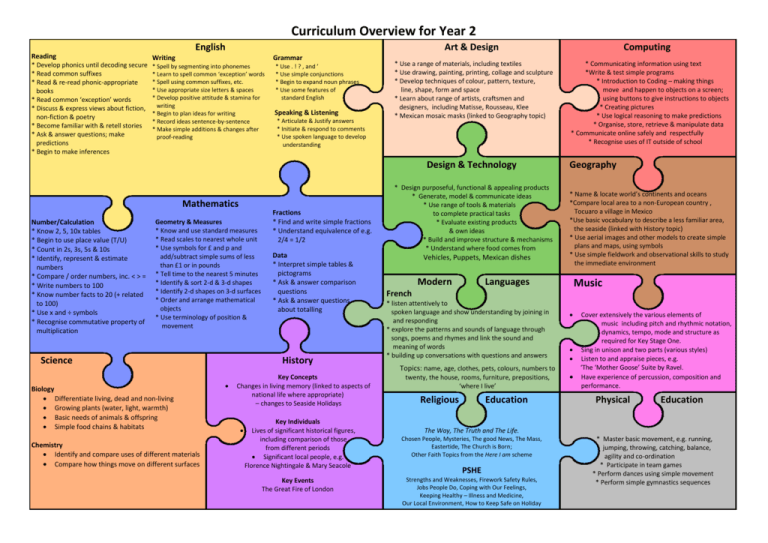
Curriculum Overview for Year 2 English Reading * Develop phonics until decoding secure * Read common suffixes * Read & re-read phonic-appropriate books * Read common ‘exception’ words * Discuss & express views about fiction, non-fiction & poetry * Become familiar with & retell stories * Ask & answer questions; make predictions * Begin to make inferences Art & Design Writing Grammar * Spell by segmenting into phonemes * Learn to spell common ‘exception’ words * Spell using common suffixes, etc. * Use appropriate size letters & spaces * Develop positive attitude & stamina for writing * Begin to plan ideas for writing * Record ideas sentence-by-sentence * Make simple additions & changes after proof-reading * Use . ! ? , and ’ * Use simple conjunctions * Begin to expand noun phrases * Use some features of standard English Speaking & Listening * Articulate & Justify answers * Initiate & respond to comments * Use spoken language to develop understanding * Use a range of materials, including textiles * Use drawing, painting, printing, collage and sculpture * Develop techniques of colour, pattern, texture, line, shape, form and space * Learn about range of artists, craftsmen and designers, including Matisse, Rousseau, Klee * Mexican mosaic masks (linked to Geography topic) Design & Technology Mathematics Number/Calculation * Know 2, 5, 10x tables * Begin to use place value (T/U) * Count in 2s, 3s, 5s & 10s * Identify, represent & estimate numbers * Compare / order numbers, inc. < > = * Write numbers to 100 * Know number facts to 20 (+ related to 100) * Use x and ÷ symbols * Recognise commutative property of multiplication Geometry & Measures * Know and use standard measures * Read scales to nearest whole unit * Use symbols for £ and p and add/subtract simple sums of less than £1 or in pounds * Tell time to the nearest 5 minutes * Identify & sort 2-d & 3-d shapes * Identify 2-d shapes on 3-d surfaces * Order and arrange mathematical objects * Use terminology of position & movement Science Biology Differentiate living, dead and non-living Growing plants (water, light, warmth) Basic needs of animals & offspring Simple food chains & habitats Chemistry Identify and compare uses of different materials Compare how things move on different surfaces Fractions * Find and write simple fractions * Understand equivalence of e.g. 2/4 = 1/2 Data * Interpret simple tables & pictograms * Ask & answer comparison questions * Ask & answer questions about totalling History Key Concepts Changes in living memory (linked to aspects of national life where appropriate) – changes to Seaside Holidays Key Individuals Lives of significant historical figures, including comparison of those from different periods Significant local people, e.g. Florence Nightingale & Mary Seacole Key Events The Great Fire of London * Design purposeful, functional & appealing products * Generate, model & communicate ideas * Use range of tools & materials to complete practical tasks * Evaluate existing products & own ideas * Build and improve structure & mechanisms * Understand where food comes from Vehicles, Puppets, Mexican dishes Modern Computing * Communicating information using text *Write & test simple programs * Introduction to Coding – making things move and happen to objects on a screen; using buttons to give instructions to objects * Creating pictures * Use logical reasoning to make predictions * Organise, store, retrieve & manipulate data * Communicate online safely and respectfully * Recognise uses of IT outside of school Geography * Name & locate world’s continents and oceans *Compare local area to a non-European country , Tocuaro a village in Mexico *Use basic vocabulary to describe a less familiar area, the seaside (linked with History topic) * Use aerial images and other models to create simple plans and maps, using symbols * Use simple fieldwork and observational skills to study the immediate environment Languages Music French * listen attentively to spoken language and show understanding by joining in and responding * explore the patterns and sounds of language through songs, poems and rhymes and link the sound and meaning of words * building up conversations with questions and answers Topics: name, age, clothes, pets, colours, numbers to twenty, the house, rooms, furniture, prepositions, ‘where I live’ Religious Education Cover extensively the various elements of music including pitch and rhythmic notation, dynamics, tempo, mode and structure as required for Key Stage One. Sing in unison and two parts (various styles) Listen to and appraise pieces, e.g. ‘The ‘Mother Goose’ Suite by Ravel. Have experience of percussion, composition and performance. Physical Education The Way, The Truth and The Life. Chosen People, Mysteries, The good News, The Mass, Eastertide, The Church is Born; Other Faith Topics from the Here I am scheme PSHE Strengths and Weaknesses, Firework Safety Rules, Jobs People Do, Coping with Our Feelings, Keeping Healthy – Illness and Medicine, Our Local Environment, How to Keep Safe on Holiday * Master basic movement, e.g. running, jumping, throwing, catching, balance, agility and co-ordination * Participate in team games * Perform dances using simple movement * Perform simple gymnastics sequences
